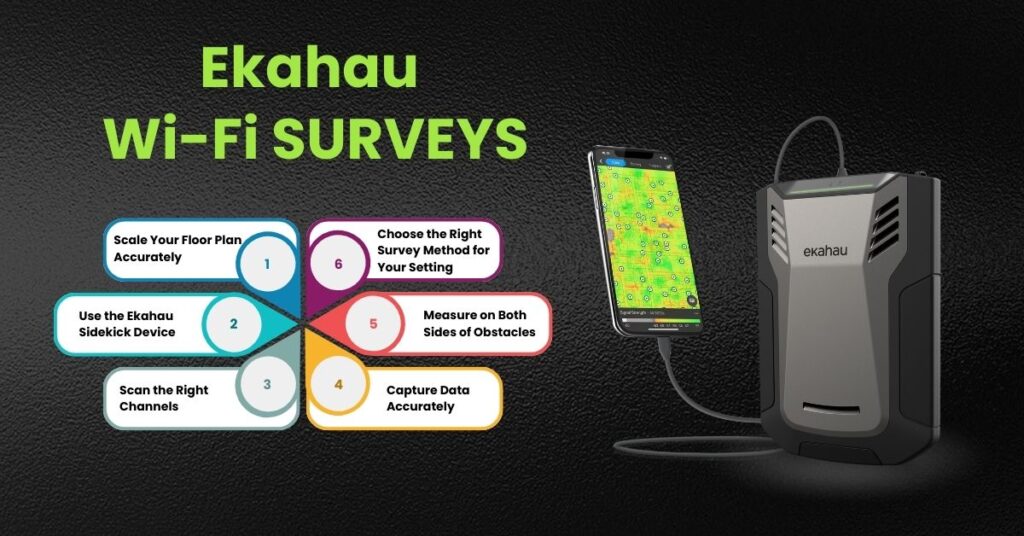Wi-Fi is a wireless technology used to connect computers, tablets, smartphones and other devices to the internet. Wi-Fi is the radio signal sent from a wireless router to a nearby device, which translates the signal into data you can see and use.
Conducting a Site Survey:
A site survey identifies any design, construction, or environmental limitations at a potential construction site. It involves a comprehensive examination of the site’s topography, soil type, vegetation, climate, existing structures and utilities, and surrounding land use.
The site survey process typically involves steps such as starting with a floor plan when possible, conducting a site visit or walkthrough, knowing what every space is used for, and understanding the environment of the area.
All businesses today that are planning to deploy or refresh their wireless networks need to start by scheduling a site survey—and for a good reason.
Site surveys allow network engineers to identify areas of RF coverage and the equipment necessary to deliver the required signal level at a given location.
Without it, planning an enterprise-grade WIFI network becomes challenging, if not impossible, causing several common problems such as:
- Coverage holes
- Excessive interference
- Incorrect types and amounts of access points
- Wasted time and money
Scale Your Floor Plan:
For any type of Wi-Fi survey, accurately scaling the floor plan is critical to ensuring precision in both your designs and validations. Don’t pick a small measurement for scaling your floor plan. If you scale a door at 1 meter but are off by 0.2 meters, your 100 meter building can be off by 20 meters!

Use the Ekahau Sidekick 2:
The Ekahau Sidekick 2 is the most advanced, all-in-one Wi-Fi diagnostic and measurement device on the market, delivering pinpoint accuracy for
Scan the Proper Channels Make sure that you are scanning what you care about. Are you in an environment that doesn’t have any 2.4 GHz APs or radios? Then you do not need to scan the 2.4 GHz channels. When you restrict the Sidekick 2 to only the channels you care about, you can scan fewer channels and have a faster scan time.
Scan the Proper Channels:
Make sure that you are scanning what you care about. Are you in an environment that doesn’t have any 2.4 GHz APs or radios? Then you do not need to scan the 2.4 GHz channels. When you restrict the Sidekick 2 to only the channels you care about, you can scan fewer channels and have a faster scan time.
Capture Accurately:
Familiarize yourself with your surroundings and ensure you are clicking and capturing data accurately. Remember: junk in, junk out. If your path shows you flying through a window or stuck in a wall, you need to re-establish your location or the data won’t be accurate. Walk on Both Sides Measure signal strength on both sides of the attenuating material that you care about in order to determine the attenuation values. The attenuation value is the absorption of a signal by obstacles like walls or racks. Never assume that measuring just one side will capture all of the data. 1 2 4 3 5 6 Measure signal strength on both sides of the attenuating material that you care about in order to determine the attenuation values. The attenuation value is the absorption of a signal by obstacles like walls or racks. Never assume that measuring just one side will capture all of the data. Familiarize yourself with your surroundings and ensure you are clicking and capturing data accurately. Remember: junk in, junk out. If your path shows you flying through a window or stuck in a wall, you need to re-establish your location or the data won’t be accurate.
Walk on Both Sides:
Measure signal strength on both sides of the attenuating material that you care about in order to determine the attenuation values. The attenuation value is the absorption of a signal by obstacles like walls or racks. Never assume that measuring just one side will capture all of the data. 1 2 4 3 5 6 Measure signal strength on both sides of the attenuating material that you care about in order to determine the attenuation values. The attenuation value is the absorption of a signal by obstacles like walls or racks. Never assume that measuring just one side will capture all of the data.
Use the Correct Survey Method for Your Environment
There is a time and place for each of the different types of survey methods Ekahau has to offer.
Stop & Go:
Best used in challenging or dangerous environments where you need to be aware of your surroundings. This survey method collects the least amount of data.
Continuous:
This traditional method of collecting survey data requires attention to detail — you need to click when you start, when you turn, when you change pace and when you stop!
Autopilot:
This method is both the coolest and the fastest! Autopilot saves you tons of time not having to click on the map as you are walking. The initial calibration is key to getting accurate results.
GPS:
This survey method is best for when you are outdoors and the map you are using does not have any reference points. You will need to have a GPS-equipped mobile device with a SIM card.

